La production de pleurotes frais
en environnement contrôlé dans la Plaine de Versailles.
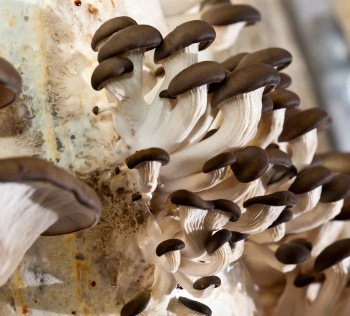
Pleurote ou pleurotte ? Parce qu’on pense souvent que le mot « pleurote » est féminin, on a tendance à l’écrire avec « -tte ». Et pourtant, le pleurote est bel et bien masculin !
Le marc de café que nous collectons chez nos entreprises partenaires entre dans la composition du substrat sur lequel nous faisons pousser nos pleurotes frais sous la marque Monte Cristo.
Alliés au marc de café, les pellets de bois, le chanvre et le lin (entre autres ingrédients) ont pour objectif de recréer un environnement propice – c’est-à-dire celui de la forêt en automne – au développement de notre produit star, le pleurote gris.
Notre process de production se déroule exclusivement en environnement contrôlé : nous pilotons la température, le taux d’humidité et le taux de gaz carbonique, de sorte que nous garantissons la même fraîcheur du produit du 1er janvier au 31 décembre pour nos clients.
Le marc de café que nous collectons chez nos entreprises partenaires entre dans la composition du substrat sur lequel nous faisons pousser nos pleurotes frais sous la marque Monte Cristo.
Alliés au marc de café, les pellets de bois, le chanvre et le lin (entre autres ingrédients) ont pour objectif de recréer un environnement propice – c’est-à-dire celui de la forêt en automne – au développement de notre produit star, le pleurote gris.
Notre process de production se déroule exclusivement en environnement contrôlé : nous pilotons la température, le taux d’humidité et le taux de gaz carbonique, de sorte que nous garantissons la même fraîcheur du produit du 1er janvier au 31 décembre pour nos clients.
Pleurote ? Vous avez dit pleurote ?
Le pleurote, corne d’abondance
La forme si particulière et poétique du pleurote lui vaut quelques comparaisons, notamment avec la corne d’abondance. La corne d’abondance, que l’on prête au dieu grec Ploutos (dieu de l’abondance et de la richesse) est un objet mythologique en forme de corne. Le pleurote par son chapeau chantant et évasé lui ressemble.
Le pleurote est comestible
Le pleurote appartient à la catégorie des champignons dits comestibles, c’est-à-dire pouvant être mangé. Sa couleur influence son goût, mais aussi sa texture. Il a tous les atouts pour vous surprendre et vous séduire. Consultez nos recettes ou nos tutos pour apprendre à le cuisiner !
Le pleurote gris
Le pleurote gris est charnu et ferme, presque croquant. Sa couleur peut varier entre le gris foncé et un gris bleuté. Son goût est délicat, plutôt boisé et légèrement sucré.
Le pleurote jaune
Le pleurote jaune est moelleux et fondant. Sa couleur est surprenante, c’est un jaune vif. Son goût est boisé avec des notes de châtaignes.
Le pleurote rose
Le pleurote rose est une variété relativement rare qui s’épanouit mieux dans des zones chaudes et humides et se caractérise par un goût plus amer et à une texture plus ferme que ses semblables, en plus de sa jolie couleur naturelle si caractéristique bien sûr.”
La forme si particulière et poétique du pleurote lui vaut quelques comparaisons, notamment avec la corne d’abondance. La corne d’abondance, que l’on prête au dieu grec Ploutos (dieu de l’abondance et de la richesse) est un objet mythologique en forme de corne. Le pleurote par son chapeau chantant et évasé lui ressemble.
Le pleurote est comestible
Le pleurote appartient à la catégorie des champignons dits comestibles, c’est-à-dire pouvant être mangé. Sa couleur influence son goût, mais aussi sa texture. Il a tous les atouts pour vous surprendre et vous séduire. Consultez nos recettes ou nos tutos pour apprendre à le cuisiner !
Le pleurote gris
Le pleurote gris est charnu et ferme, presque croquant. Sa couleur peut varier entre le gris foncé et un gris bleuté. Son goût est délicat, plutôt boisé et légèrement sucré.
Le pleurote jaune
Le pleurote jaune est moelleux et fondant. Sa couleur est surprenante, c’est un jaune vif. Son goût est boisé avec des notes de châtaignes.
Le pleurote rose
Le pleurote rose est une variété relativement rare qui s’épanouit mieux dans des zones chaudes et humides et se caractérise par un goût plus amer et à une texture plus ferme que ses semblables, en plus de sa jolie couleur naturelle si caractéristique bien sûr.”
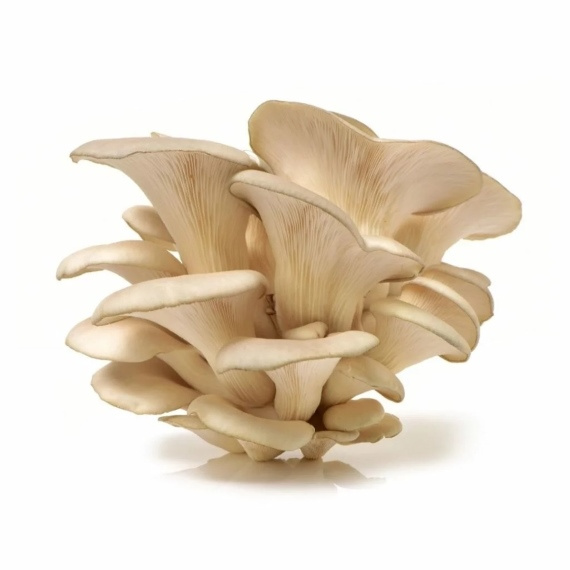
Pourquoi cultiver des champignons avec votre marc de café ?
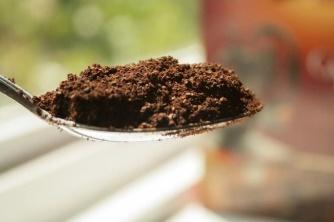
La culture domestique de champignons comporte bon nombre d’avantages. Tout d’abord, vous recyclez vos déchets : le marc de café permet de créer un excellent substrat à la culture de champignons, comme nous le faisons avec nos pleurotes Monte Cristo.
Ensuite, la culture vous permet de comprendre comment le champignon pousse, quelles sont ses particularités. Cela revêt un aspect ludique très appréciable.
Vous le récoltez vous-même : vous optez pour un circuit-court, sans intermédiaire. Vous limitez ainsi votre empreinte carbone.
Enfin, vous consommez frais : vous cultivez, vous récoltez et vous cuisinez !
Ensuite, la culture vous permet de comprendre comment le champignon pousse, quelles sont ses particularités. Cela revêt un aspect ludique très appréciable.
Vous le récoltez vous-même : vous optez pour un circuit-court, sans intermédiaire. Vous limitez ainsi votre empreinte carbone.
Enfin, vous consommez frais : vous cultivez, vous récoltez et vous cuisinez !
L’économie circulaire
Pour faire simple, l’économie circulaire est une économie basée sur la transformation du déchet en ressource : on recycle et on limite le gaspillage en donnant une seconde vie aux objets, aux déchets ou plus largement aux produits. Elle repose sur les principes du développement durable, parce qu’elle a le moins possible recours aux processus polluants ou gourmands en énergie, et récupère les matières premières pour les transformer.
Pourquoi des pleurotes ?
Les pleurotes mangent du bois. Ils peuvent pousser partout où il y en a, si les conditions d’un sous-bois sont recréées. C’est ce que nous vous proposons d’expérimenter chez vous, avec la Boîte à Champignons. Cultiver une morille est un peu plus périlleux : il faut un chêne vieux de 10 ans ; pour cultiver une girolle, il faut une forêt dans un climat tempéré. On a donc naturellement opté pour le pleurote !
Cultiver avec un engrais naturel et organique
Notre chaîne d’économie circulaire permet d’obtenir des pleurotes de très haute qualité. Deux fois plus concentrés en matière sèche qu’un pleurote conventionnel, les Monte Cristo sont très riches en arômes. Leur consistance et leur maintien autorisent tous types de préparation. C’est la raison pour laquelle Yannick et les Chefs du Collège Culinaire de France ont choisi ce champignon pour leur restaurant.
Pour Grégoire, « avec le marc de café, en plus de préserver la paille traditionnellement utilisée pour la culture du pleurote, on développe une méthode de culture qui améliore le produit final ».
Ce à quoi Arnaud ajoute que « le résidu des cultures de pleurotes est beaucoup plus enrichissant pour la terre que si vous y mettiez simplement du marc de café. »
Comment faire pousser des champignons avec du marc de café ?
Il vous faut créer un substrat de mycélium, que vous pouvez réaliser à partir de votre marc de café. Mélangez-le avec des copeaux de bois. Ensuite, il vous faut le matériel pour créer l’humidité nécessaire au développement des champignons : nous vous proposons de déposer ce substrat dans un sac micro-perforé.
Ensuite, il suffit de suivre notre mode d’emploi pas à pas pour cultiver simplement vos champignons : mettre le sac dans le noir pour le laisser incuber, puis créer un choc thermique en le laissant une nuit au réfrigérateur.
Enfin, ouvrir le sac pour laisser les champignons respirer et les vaporiser chaque jour d’un peu d’eau. La pousse prend ensuite une quinzaine de jours. Un jeu d’enfant !
Cultiver avec un engrais naturel et organique
Notre chaîne d’économie circulaire permet d’obtenir des pleurotes de très haute qualité. Deux fois plus concentrés en matière sèche qu’un pleurote conventionnel, les Monte Cristo sont très riches en arômes. Leur consistance et leur maintien autorisent tous types de préparation. C’est la raison pour laquelle Yannick et les Chefs du Collège Culinaire de France ont choisi ce champignon pour leur restaurant.
Pour Grégoire, « avec le marc de café, en plus de préserver la paille traditionnellement utilisée pour la culture du pleurote, on développe une méthode de culture qui améliore le produit final ».
Ce à quoi Arnaud ajoute que « le résidu des cultures de pleurotes est beaucoup plus enrichissant pour la terre que si vous y mettiez simplement du marc de café. »
Comment faire pousser des champignons avec du marc de café ?
Il vous faut créer un substrat de mycélium, que vous pouvez réaliser à partir de votre marc de café. Mélangez-le avec des copeaux de bois. Ensuite, il vous faut le matériel pour créer l’humidité nécessaire au développement des champignons : nous vous proposons de déposer ce substrat dans un sac micro-perforé.
Ensuite, il suffit de suivre notre mode d’emploi pas à pas pour cultiver simplement vos champignons : mettre le sac dans le noir pour le laisser incuber, puis créer un choc thermique en le laissant une nuit au réfrigérateur.
Enfin, ouvrir le sac pour laisser les champignons respirer et les vaporiser chaque jour d’un peu d’eau. La pousse prend ensuite une quinzaine de jours. Un jeu d’enfant !
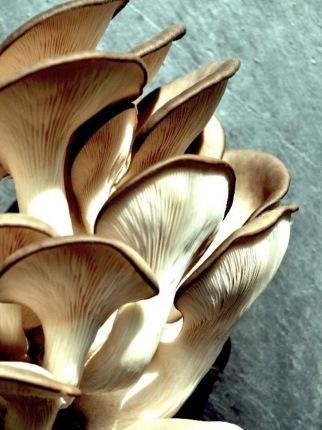
La culture de pleurote sur du marc de café
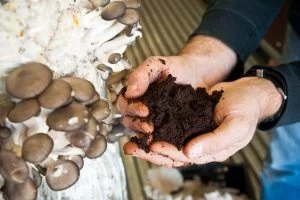
Nos pleurotes Monte Cristo sont cultivés en Île-de-France dans les Yvelines, sur un substrat à base de marc de café. En souhaitant valoriser un déchet organique qui se prête très facilement à la culture de champignons, nous avons découvert qu’il améliore même les spécificités propres au pleurote. Il lui donne goût et texture. Et la bonne nouvelle, c’est que vous aussi vous pouvez le faire chez vous ! Pas besoin de grands espaces, la culture du pleurote se prête parfaitement aux intérieurs. La recette est simple : imiter la nature, selon le principe de la permaculture. On reproduit l’écosystème naturel du champignon (température, ensoleillement, niveau d’humidité…) en utilisant un déchet organique produit en quantité dans notre société : le marc de café. On donne ainsi une seconde vie à un élément organique se prêtant parfaitement à l’exercice.
Comment cultiver ?
La préparation du substrat : on pasteurise le marc collecté, on le mélange avec le mycélium de pleurote.
L’incubation : on laisse la préparation dans un sac, dans le noir une vingtaine de jours.
Le choc : pour que les champignons sortent, on crée un choc thermique semblable aux fraîches nuits d’automne.
La culture : on aère et on vaporise le substrat chaque jour pour qu’il reste humide. Les champignons adorent l’humidité !
La récolte : on cueille à la main nos petits champignons en les saisissant par grappes.
La fertilisation : on récupère le substrat enrichi et on le donne à nos plantes.
L’incubation : on laisse la préparation dans un sac, dans le noir une vingtaine de jours.
Le choc : pour que les champignons sortent, on crée un choc thermique semblable aux fraîches nuits d’automne.
La culture : on aère et on vaporise le substrat chaque jour pour qu’il reste humide. Les champignons adorent l’humidité !
La récolte : on cueille à la main nos petits champignons en les saisissant par grappes.
La fertilisation : on récupère le substrat enrichi et on le donne à nos plantes.